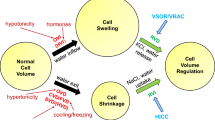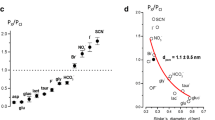Abstract
Cell swelling activates an outwardly rectifying anion current in numerous mammalian cell types. An extensive body of evidence indicates that the channel responsible for this current is the major pathway for volume regulatory organic osmolyte loss. Cell swelling also activates an outwardly rectifying anion current in Xenopus oocytes. Unlike mammalian cells, oocytes allow the direct study of both swelling-activated anion current and organic osmolyte efflux under nearly identical experimental conditions. We therefore exploited the unique properties of oocytes in order to examine further the relationship between anion channel activity and swellingactivated organic osmolyte transport. Swelling-activated anion current and organic osmolyte efflux were studied in parallel in batches of oocytes obtained from single frogs. The magnitude of swelling-activated anion current and organic osmolyte efflux exhibited a positive linear correlation. In addition, the two processes had similar pharmacological characteristics and activation, rundown and reactivation kinetics. The present study provides further strong support for the concept that the channel responsible for swelling-activated Cl− efflux and the outwardly rectifying anion conductance is also the major pathway by which organic osmolytes are lost from vertebrate cells during regulatory volume decrease.
Similar content being viewed by others
References
Ackerman, M.J., Wickman, K.D., Clapham, D.E. 1994. Hypotonicity activates a native chloride current in Xenopus oocytes. J. Gen. Physiol. 103:153–179
Ballatori N., Truong, A.T., Jackson, P.S., Strange, K., Boyer, J.L. 1995. ATP depletion and inactivation of an ATP-sensitive taurine channel by classic ion channel blockers. Molec. Pharm. 48:472–476
Banderali, U., Roy, G. 1992. Anion channels for amino acids in MDCK cells. Am. J. Physiol. 263:C1200-C1207
Boese, S.H., Wehner, F., Kinne, R.H.K. 1996. Taurine permeation through the swelling-activated anion conductance in rat IMCD cells in primary culture. Am. J. Physiol. 271:F498-F507
Buccione, R., Cecconi, S., Tatone, C., Mangia, F., Colonna, R. 1987. Follicle cell regulation of mammalian oocyte growth. J. Exp. Zool. 242:351–354
Dascal, N. 1987. The use of Xenopus oocytes for the study of ion channels. CRC Crit. Rev. Biochem. 22:317–387
Emma, F., McManus, M., Strange, K. 1995. Modulation of VSOAC volume set-point by intracellular electrolyte levels. J. Gen. Physiol. 108:23a (Abstr.)
Fiévet, B., Gabillat, N., Borgese, F., Motais, R. 1995. Expression of band 3 anion exchanger induces chloride current and taurine transport: structure-function analysis. EMBO J. 14:5158–5169
Hallberg, R.L., Smith, D.C. 1976. In vivo and in vitro hormonal effects on the metabolism of immature oocytes of Xenopus laevis. Develop. Biol. 48:308–316
Jackson, P.S., Churchwell, K., Ballatori, N., Boyer, J.L., Strange, K. 1996. Swelling-activated anion conductance in skate hepatocytes: regulation by cell Cl− and ATP. Am. J. Physiol. 270:C57-C66
Jackson, P.S., Morrison, R., Strange, K. 1994. The volume-sensitive organic osmolyte-anion channel VSOAC is regulated by nonhydrolytic ATP binding. Am. J. Physiol. 267:C1203-C1209
Jackson, P.S., Strange, K. 1993. Volume-sensitive anion channels mediate swelling-activated inositol and taurine efflux. Am. J. Physiol. 265:C1489-C1500
Kirk, K., Ellory, J.C., Young, J.D. 1992. Transport of organic substrates via a volume-activated channel. J. Biol. Chem. 267:23475–23478
Miledi, R., Woodward, R.M. 1989. Effects of defolliculation on membrane current responses of Xenopus oocytes. J. Physiol. 416:601–621
Roy, C., Malo, C. 1992. Activation of amino acid diffusion by a volume increase in cultured kidney (MDCK) cells. J. Membrane Biol. 130:83–90
Sanchez-Olea, R., Pena, C., Moran, J., Pasantes-Morales, H. 1993. Inhibition of volume regulation and efflux of osmoregulatory amino acids by blockers of Cl− transport in cultured astrocytes. Neurosci. Letters 156:141–144
Strange, K., Emma, F., Jackson, P.S. 1996. Cellular and molecular physiology of volume-sensitive anion channels. Am. J. Physiol. 270:C711-C730
Strange, K., Jackson, P.S. 1995. Swelling-activated organic osmolyte efflux: a new role for anion channels. Kidney Intl. 48:994–1003
Author information
Authors and Affiliations
Additional information
This work was supported by National Institutes of Health grant NS30591. K. Strange is an Established Investigator of the American Heart Association. M. Hand was supported in part by NIH training grant T32-DK77726.
Rights and permissions
About this article
Cite this article
Hand, M., Morrison, R. & Strange, K. Characterization of volume-sensitive organic osmolyte efflux and anion current in Xenopus oocytes. J. Membrane Biol. 157, 9–16 (1997). https://doi.org/10.1007/s002329900211
Received:
Revised:
Issue Date:
DOI: https://doi.org/10.1007/s002329900211




